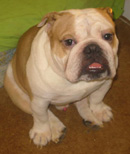How to Breed English Bulldogs
Count 60-63 days before the puppies are likely to be born making sure everything necessary for their arrival will be in order by that time. Note; semen can hold in the bitch for up to 3 days, so be careful not to expect them too early. Example: If she has passed 63 days and you have no puppies she may have not "taken" the day you thought she did. It could be a few more days.
Alert your veterinarian a week before the puppies are due and start observing the bitch for signs of labor. She will generally stop eating 24 hours before whelping.
Remember that as much as a week before, she will begin "nesting". The bitch should be given a whelping box with layers of newspaper (black and white only) to make her nest. She will dig more and more as birth approaches. Tempatures can also be taken often but are not always reliable. Don't be lead into a false security with that alone. Even with a c-section planned it is a good thing to let her nest!
Remember that sudden gush of green fluid from the bitch indicates the water surrounding the pups has "broken". When the water breaks, birth of the first puppy is imminent. The first puppies are usually born within minutes to half an hour of each other, but a couple of hours is not uncommon. If you notice the bitch straining constantly without producing a puppy, it is cause for concern.
Set up your C-Section with your vet well in advance of delivery. It may be best to allow the bitch to start or get real close to starting labor before doing this to avoid a C-Section too early which can have dangerous complications. This will also depend on your vet and how close his office is to you as well as if he is able to do a 3 am C-Section. If you do a C-Section just because the Bulldog has reached her 62-63 day, the puppies could still be a few days early as semen can live in the bitch for up to 3 days before it takes sometimes. If the bitch should go on into labor on her own even if she is planned for a C-Section, get her to the vet right away. Her cervix may fail to dilate or there may be torsion of the uterus. A dead puppy, water puppy or a sideways puppy could be blocking the cervix. No matter what the cause, get the bitch to the vet immediately.
Remember that tests can also be done to get a date for c section in advance and during a safe and normal hour so chances of problems will be reduced.
Keep in mind that after the surgery, when the bitch is home in her whelping box, she may nurse the pups under your supervision. Bulldogs are commonly C-sectioned (about 95%) due to their size (head and shoulders), exhaustion, failure to progress in labor, over heating and other reasons. Plan on visiting with your vet about when you will likely do a C-section well in advance of delivery! PUPPIES should be allowed to nurse on mom the first couple of days at all cost, this is very important in there development unless the bitch is running a fever. Milk will usually come down within 2 days of birth, real true milk.
Remember that free whelping Bulldogs is starting to be more common than it used to be, however free whelping is a very tricky situation even for those with a great deal of experience in doing it. Never should you attempt a free whelp without a great deal of experience, a good vet, the ability to understand when a problem may be starting, and a backup plan to aid you if needed. Be safe, not sorry! Danger...Danger...Danger!
Acknowledge that C-sections for Bulldogs are very common. The reasons for c-section are discussed later on this page. In recent years, more Bullies are free-whelping and it is improving the breed (anything that could be done without surgery is a major improvement).However c-sections are still common and done far more than free-whelps, like 95% of the tine. You should plan on a c-section for your bitch unless she has been cleared by a vet for free-whelping, then plan on letting her deliver at the vet clinic. This is one reason breeding Bulldogs should be left to those with a great deal of experience. (EXTREME CAUTION MUST BE TAKEN WHEN A BULLLDOG IS FREE-WHELPING, EVEN UNDER PERFECT CONDITIONS). C-section of a Bulldog is the most prefered way and the safest! Do NOT attempt a free whelp.
BREED the best to the best - only healthy, well adjusted females that have been in season at least twice, are at least 18 months old, and are descended from dogs free of major defects should be considered for breeding. The bitch descended from the rare free-whelp mother (i.e., one who can deliver puppies on her own) is an especially prime candidate for breeding.
Do not breed unless you have plans that will include the proper long term commitment to the breed, the health and safety of the bitch and puppies, and the ability to completely understand the Bulldog and its needs. There are too many backyard breeders trying to jump in and breed dogs with almost no experience or understanding of this unique breed. They see the prices they sell for and try to get in and fill their pockets with money. The sad part about that is the end result is not good for the Bulldog.
Remember that this is not a breed that you just put two dogs together and forget, let the mother deliver and forget, let the mother raise solely the litter and forget. In the mean time the breed suffers. It can take many years for responsible breeders to correct the damage done by a few backyard breeders. If you really want to breed Bulldogs, take some time to understand the breed, do research, attend shows, talk with breeders, judges, and those who have spent years with this breed. Once you have decided you still want to breed, get help. Find someone who has a great deal of experience to mentor you, teach you, and give you the advise you need. You should own Bulldogs for many years before breeding them in the best conditions.
Compliment the breed by breeding to improve it. Find the proper mating pair. Breeding out faults and improving the breed is what it's about. You will not make any money from breeding Bulldogs if you do it the right and the only way it should be done. You do it for the love of the breed and to try to improve it. And the first rule is first of all do no harm. Breeding Bulldogs is very difficult at best, very expensive, and time consuming. It is a 24 hour a day commitment. Once you have decided this is still what you want and you have done all this the right way, then decide why you are breeding. You will be improving the breed through what method? What is your plan? This is a loving breed that needs the respect and care of those willing to provide it for years to come.
Remember that there is no shortage of good pets in this country and the animal shelters are full of pets needing good homes. Many dogs who come from puppymills, backyard breeders, and farm operations have health problems that will be passed on to their future litters by breeding them. Most of these people will not do any pedigree research as well. Over 75% of the reasons a Bulldog ends up in a rescue or animal shelter is health related problems which were likely genetic. Good breeders look to compliment the breed through careful breeding and improvement.
Be cautious and understand fully what risk may be involved. There are many cases where a Bulldog and the litter have died from, during, or after a delivery, or during pregnancy from some sort of complication.You must be aware of your dates as there have been several cases where puppies was taken to early and the litter dies since the lungs is the last thing to mature.
Remember that the best days to palpate (feel for) puppies are about day 28 to day 35 of the pregnancy. Usually it is best to count from the last breeding day as most dogs actually ovulate shortly before they quit standing for the male.
Keep in mind that X-rays can confirm pregnancy after 45 days. Sometimes it is worthwhile to take X-rays to get an idea of the number of puppies -- usually done if your vet suspects that there are problems or if the bitch has had trouble delivering puppies previously, or for C-section reasons.
Try to gradually change the bitch to a puppy formula dog food at about the 35th day of the pregnancy (take about a week to slowly make the change, mixing in small amounts of puppy food with normal food the first day and gradually increasing the amount). Most bitches require about 1.5 times the normal amount of food for their maintenance at the time of birth. As the puppies grow, she may require as much as 3 times normal amounts of food to support lactation. You should continue to keep her on a puppy formula until the puppies are weaned. Do not supplement calcium during the pregnancy. This seems to lead to problems with uterine inertia. It may also contribute to the frequency of seizure problems associated with low blood calcium levels during lactation (milk tetany).
Know your veterinarian's emergency procedures before the delivery. If your vet refers emergencies to an emergency clinic, make sure you know where it is and how to call if you need help. If your veterinary hospital staff covers its own emergencies it is still important to know the procedure for contacting someone before the need arises. Ask about this. Write the phone numbers down where you can easily find them. Providing a safe environment for the puppies is important. More puppies die from hypothermia than anything else. Making arrangements to ensure the puppies will stay warm is important. The puppy heating pads are nice and sometimes other arrangements can be made to safely supply a warm spot for the puppies without making it too hot for the mother. Breeders are a good source of information in most cases and it would be a good idea to continue to try to talk to yours. They often have practical information that vets don't have experience with.
Remember that false pregnancy symptoms are normal in dogs that have an estrus and do not get bred, due to the way in which they cycle. It is not usually necessary to treat for symptoms of false pregnancy but they can be so close to those of a real pregnancy that the two can be very confusing. It is usually possible to feel distinct lumps in the uterus representing individual embryos from about the 28th day of pregnancy to about the 35th day of pregnancy. Before and after that it can be hard to identify a pregnant uterus easily. After 45 days or so when the skeletons begin to calcify it is often possible to feel the distinct hardness of a puppy skull when palpating the abdomen or to identify the puppies on an X-ray, if you wish to take her to the vet's office prior to the home visit, or if your vet has a portable X-ray machine. By now, if your dog is NOT pregnant, your vet will probably be able to tell you that, since she should be pretty far into the pregnancy and at least uterine enlargement should be palpable.
Keep in mind that the average heat cycle for a dog is approximately 3 weeks and since this an an average, some heats are shorter (as little as 7-10 days), others are longer (4 weeks or more). Average times between heat periods is seven months but some dogs can cycle as early as every 4 months, some once a year. Lengths of heat cycles and intervals between cycles are different for each dog but most dogs hit somewhere close to the averages.
Keep a close eye on your dog. The first part of heat you will notice bleeding from the vulva, swelling of the vulva, possible increase in urination and the most noticeable, male dogs hanging around the house. During this period (proestrus), females will not allow the males to breed with them although the males will be very persistent. The second part or estrus is the time in which the female will allow the male to breed her and this can last anywhere from 4-10 days. A female, most of the time, will allow most any male to breed during this time. As the female starts to go out of heat or enter diestrus, she will be less willing to breed. Again this stage can last 4-11 days but averages approximately 7 days. The next cycle usually begins about 7 months from the start of the last heat cycle, not the end of that cycle but again this varies from dog to dog. The interval stays the same even if she becomes pregnant.
Consider spaying your bitch if you do not intend to breed her. There are many health benefits associated with spaying such as decreased chance of mammary tumors and you will not have to worry about pyometra, metritis or unwanted litters (overpopulation is a big problem - just take a trip to a humane shelter). If you elect to spay her, this should not be done during her heat cycle because of the risk of excessive bleeding and other complications. The best idea is to wait until she has been out of heat for a few weeks.
Tips
C-sections for Bulldogs are very common. The reasons for c-section are discussed later on this page. In recent years, more Bullies are free-whelping and it is improving the breed (anything that could be done without surgery is a major improvement). However c-sections are still common and done far more than free-whelps, like 95% of the tine. You should plan on a c-section for your bitch unless she has been cleared by a vet for free-whelping, then plan on letting her deliver at the vet clinic. This is one reason breeding Bulldogs should be left to those with a great deal of experience. (EXTREME CAUTION MUST BE TAKEN WHEN A BULLLDOG IS FREE-WHELPING, EVEN UNDER PERFECT CONDITIONS). C-section of a Bulldog is the most prefered way and the safest! Do NOT attempt a free whelp.
The best advice seems to be not breeding your dogs before 18 months of age. Both the bitch and the sire should have been examined by a veterinarian to be certain they are free and clear of hip dysplasia, cataracts, cherry eye, palate problems, heart conditions and other congenital diseases. You should have also studied the pedigree, and spent a lot of time assuring that you have a good breeding pair that will compliment each other and produce a better quality puppy. Under no condition should you do any harm to the breed through faulty breeding and lack of experience on your part. If you are not sure, then you should not be breeding bulldog's. The Bulldog is, at best, difficult to breed. Bitches can come into there first heat cycle from 5 to 11 months of age, on average it is more in the 6-9 month range. They should not be breed before there 3rd heat or 18 months. Heat cycles usually last about 3 weeks start to finish. You may noitce lite red/brown spots at first and then some bitches will bleed a great deal after the first week. Best breeding time is usally 8-12 days, but again can be from 5 to 18 days into the cycle so it's im
ARTIFICAL INSEMINATION: Breeding by means of A.I. is usually successful, (and almost always required). The technique for artifical insemination requires the depositing of semen (taken directly from the dog) into the bitch's vagina, past the cervix and into the uterus by syringe. The correct temperature of the semen is vital, and there is no guarantee. Methods include fresh semen, cooled extended and frozen semen.
Progesterone Testing
Are you feeling stressed as your bitch's due date approaches? Worried that you are going to waste the last vial of frozen semen from your champion stud?A successful breeding program does not have to consist of one panic-laden situation to the next, but all too often this occurs. As a veterinarian working in a practice that sees over 900 dogs for artificial insemination and performs over 250 cesarean sections annually, I have learned to rely on and have confidence in the value of accurate and timely progesterone testing in the bitch. Although it seems that some people thrive under stressful conditions, replacing panic with informative scientific data invariably results in larger, healthier litters and happier owners. In today's era of CO-ownership of valuable stud dogs and breeding bitches, it is not uncommon to have four or six differing opinions on the timing of a breeding.
Indeed there are a lot of options. One breeding or two? Should it be a natural, vaginal, transcervical, or surgical breeding? The questions mount and the stress can build, but if you are armed with a basic working knowledge of the bitch's reproductive system and accurate progesterone tests, you can make good decisions. The progesterone test is your best friend. First, let's review the basics. Prior to coming in season (estrus), serum progesterone levels in the bitch are low, less than 2ng (ng=nanograms). As the cycle continues, progesterone levels slowly climb to a level of 5ng, upon which ovulation occurs. The ovulation date can be as early as day 7 and as late as day 27 of the estrous cycle, emphasizing the importance of the blood test. Once a bitch hits 5ng and ovulates, subsequent serum progesterone levels can vary greatly. For example, at three days post ovulation we routinely see progesterones that may range from as low as lOng to as high as 60ng, depending on the bitch. For ovulation purposes we are only interested in the day she exceeds 5ng. I commonly get the question, "Doc, we only ran one progesterone test on my bitch and it was 15ng, when did she ovulate?" The answer is impossible to know based on one test.
I have seen bitches at 15ng one day after ovulation as well as 5, 10, 20, or 40 days after ovulation. You must have one test below 5ng and one above 5ng to determine ovulation day. For most bitches we start testing 6 days after the onset of vulvar swelling and bleeding, and we test every 1-3 days until ovulation, depending on the situation. After ovulation, serum progesterone levels will remain elevated, regardless of whether or not the bitch is pregnant, for approximately two months, at which point they return to near Ong. It is important to note that vaginal bleeding, swelling, "flagging," and receptivity to males is predominantly a response to estrogen's in the bitch's bloodstream, and not a reliable indicator of progesterone and consequently ovulation. She mayor may not be receptive at the proper time. The use of physical indicators alone for breeding may not be a chance worth taking, especially with valuable semen. So what does knowing the ovulation day do for us? It tells us when the eggs will be fertile, which is important with all breeding, but especially so with fresh chilled extended semen and with frozen semen.
Once ovulated, a bitch's eggs take approximately 48 hours to become fertile. They will then remain fertile for approximately 48 hours. The idea is to maximize contact time between viable semen and fertile eggs. This requires a brief discussion of semen longevity. Fresh semen can remain fertile in the bitch's uterus for 3-5 days and in some cases even longer, depending on quality. Fresh chilled semen, because of energy lost in the cooling and subsequent warming process, may live only 24-48 hours in the uterus. Frozen semen, due to the stress of the freezing process and energy lost, may live only 12-24 hours in the uterus. Clearly, the shorter the sperm's life span, the more paramount it becomes to know when it should be inseminated to allow for maximum contact time with fertile eggs. In the case of fresh semen, there is more flexibility for two reasons. First, there is usually not a limited quantity, and second, it lives a long time. We routinely recommend breeding days 1 and 3 or days 2 and 4 post ovulation with fresh semen, though one breeding is usually sufficient. With fresh chilled extended semen, because of a 24-48 hour life span, we recommend breeding 2 days after ovulation.
As we discussed earlier, the bitch's eggs are just becoming fertile at this point, so we should have 1-2 days of good contact time. In the case of frozen semen, we recommend waiting three days after ovulation to do the breeding. This may make our clients nervous that we are waiting too long. However, it ensures that all the eggs are fertile when we put semen into the uterus that may live only 12 hours. We do not have the luxury of waiting around for eggs to become fertile. We have found the highest levels of success with frozen semen following surgical insemination and recommend it exclusively. Our levels of success using the above timing recommendations have been excellent; however, the manner in which a bitch is bred natural, vaginal insemination, transcervical insemination with an endoscope, or surgical insemination-must be carefully considered depending on factors such as reproductive history, age, physical characteristics, and semen quality. Having an accurate ovulation date at the beginning of a pregnancy is also very important at the end of a pregnancy.
A bitch's due date is 63 days from ovulation, regardless of breeding days. This is extremely valuable for planned c-sections, due to such factors as breed conformation, litter size, prior medical history, or complications arising during the pregnancy. It is also very helpful when whelping. Knowing an exact due date not only helps breeders prepare for the arrival of a litter, but, often more importantly, it can alert us to a premature or overdue labor, allowing for prompt medical intervention if indicated. Progesterone monitoring can also be important during gestation. Some bitches have a problem maintaining adequate levels of progesterone during a pregnancy, usually resulting in resorbed or aborted fetuses. Monitoring progesterone levels is critical in bitches with such histories, as supplementation of progesterone at the proper times could mean the difference between live or dead puppies. Often we are confronted with owners who have difficulty "catching" a bitch's heat cycle. This is usually due to minimal outward physical signs such as vulvar swelling and bleeding. We recall that progesterone levels stay elevated for approximately two months after ovulation in all bitches, whether pregnant or not. Obtaining an elevated progesterone level in such an animal at the very least indicates she was in season in the last two months, often helping a breeder know approximately when to expect the next cycle. Conversely, a low progesterone level, less than 2.5ng, means there have been no eggs ovulated in the past two months.
This may alert a breeder to an upcoming cycle, or, if the level remains chronically low, the veterinarian may be alerted to begin a thorough medical workup. The usefulness of accurate and timely progesterone testing should not be underestimated. It is a valuable tool and in some cases of critical importance in helping a veterinarian and breeder choose the proper course of action. Proper use and interpretation of these tests will result in not only more pregnancies, but larger, healthier litters, fewer complications with your bitch, insight into potential problems, and, as I have experienced, fewer panicked telephone calls at three 0' clock in the morning.
Warnings
The best advise is not to breed unless you have plans that will include the proper long term commitment to the breed, the health and safety of the bitch and puppies, and the ability to completely understand the Bulldog and its needs. There are too many backyard breeders trying to jump in and breed dogs with almost no experience or understanding of this unique breed. They see the prices they sell for and try to get in and fill their pockets with money. The sad part about that is the end result is not good for the Bulldog.
This is not a breed that you just put two dogs together and forget, let the mother deliver and forget, let the mother raise solely the litter and forget. In the mean time the breed suffers. It can take many years for responsible breeders to correct the damage done by a few backyard breeders. If you really want to breed Bulldogs, take some time to understand the breed, do research, attend shows, talk with breeders, judges, and those who have spent years with this breed. Once you have decided you still want to breed, get help. Find someone who has a great deal of experience to mentor you, teach you, and give you the advise you need. You should own Bulldogs for many years before breeding them in the best conditions.
You must also compliment the breed by breeding to improve it. Find the proper mating pair. Breeding out faults and improving the breed is what it's about. You will not make any money from breeding Bulldogs if you do it the right and the only way it should be done. You do it for the love of the breed and to try to improve it. And the first rule is first of all do no harm. Breeding Bulldogs is very difficult at best, very expensive, and time consuming. It is a 24 hour a day commitment. Once you have decided this is still what you want and you have done all this the right way, then decide why you are breeding. You will be improving the breed through what method? What is your plan? This is a loving breed that needs the respect and care of those willing to provide it for years to come.
There is no shortage of good pets in this country and the animal shelters are full of pets needing good homes. Many dogs who come from puppymills, backyard breeders, and farm operations have health problems that will be passed on to their future litters by breeding them. Most of these people will not do any pedigree research as well. Over 75% of the reasons a Bulldog ends up in a rescue or animal shelter is health related problems which were likely genetic. Good breeders look to compliment the breed through careful breeding and improvement.
WikyHow
 BULLDOG
BULLDOG  BULLDOG
BULLDOG  BULLDOG
BULLDOG  BULLDOG
BULLDOG  BULLDOG
BULLDOG  BULLDOG
BULLDOG 



































